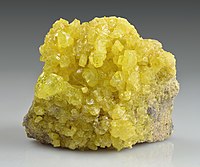
Photo from wikipedia
Catalyzing polysulfide conversion is a promising way toward accelerating complex and sluggish sulfur redox reactions (SRRs) in lithium-sulfur batteries. Reasonable alteration of an enzyme provides a new means to expand… Click to show full abstract
Catalyzing polysulfide conversion is a promising way toward accelerating complex and sluggish sulfur redox reactions (SRRs) in lithium-sulfur batteries. Reasonable alteration of an enzyme provides a new means to expand the natural enzyme universe to catalytic reactions in abiotic systems. Herein, we design and fabricate a denatured hemocyanin (DHc) to efficiently catalyze the SRR. After denaturation, the unfolded β-sheet architectures with exposed rich atomically dispersed Cu, O, and N sites and intermolecular H-bonds are formed in DHc, which not only provides the polysulfides for a strong spatial confinement effect in microenvironment via S-O and Li···N interactions but also activates chemical channels for electron/Li+ transport into the Cu active center via H/Li-bonds to catalyze polysulfide conversion. As expected, the charge/discharge kinetics of DHc-containing cathodes is fundamentally improved in cyclability with nearly 100% Coulombic efficiency and capacity even under high sulfur loading (4.3 mg cm-2) and lean-electrolyte (8 μL mg-1) conditions.
Journal Title: ACS applied materials & interfaces
Year Published: 2023
Link to full text (if available)
Share on Social Media: Sign Up to like & get
recommendations!